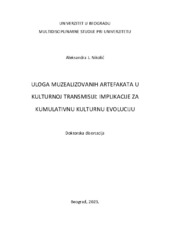Prikaz osnovnih podataka o disertaciji
Uloga muzealizovanih artefakata u kulturnoj transmisiji: implikacije za kumulativnu kulturnu evoluciju
The role of musealized artefacts in cultural transmission : implications for cumulative cultural evolution
| dc.contributor.advisor | Krstović, Nikola | |
| dc.contributor.other | Cvetković, Dragana | |
| dc.contributor.other | Božić Marojević, Milica | |
| dc.contributor.other | Blagojević, Jelena | |
| dc.contributor.other | Damnjanović, Kaja | |
| dc.creator | Nikolić, Aleksandra J., | |
| dc.date.accessioned | 2023-11-28T19:40:58Z | |
| dc.date.available | 2023-11-28T19:40:58Z | |
| dc.date.issued | 2023-09-19 | |
| dc.identifier.uri | https://eteze.bg.ac.rs/application/showtheses?thesesId=9334 | |
| dc.identifier.uri | https://fedorabg.bg.ac.rs/fedora/get/o:31745/bdef:Content/download | |
| dc.identifier.uri | https://plus.cobiss.net/cobiss/sr/sr/bib/130882825 | |
| dc.identifier.uri | https://nardus.mpn.gov.rs/handle/123456789/21934 | |
| dc.description.abstract | Polazište disertacije je u shvatanju važnosti artefakata kao podrške učenju i muzeja kao strukture koja institucionalizuje kulturno trajanje. Sa ciljem da se bliže odrede svojstva i kapaciteti artefakata kao sredstva kulturne transmisije kakva se odvija u muzeju, pristup u okviru ove disertacije je teorijski i empirijski. Hipotetičko-deduktivnim metodom je definisano učenje putem artefakata kao društveno učenje i uspostavljena veza između kulturnog i ekološkog nasleđa kroz teorije muzeologije, heritologije i kulturne evolucije, te teoriju konstrukcije niša u okviru Proširene sinteze, nove i inkluzivnije teorije evolucije. Metodom eksperimentalne simulacije ispitivan je uticaj fizičkog stanja artefakta na njegov medijacioni kapacitet, a kreiranjem i testiranjem računarskog modela učenja putem artefakata u muzeju je proveravano pitanje uticaja elemenata muzejskog konteksta na ovaj tip kulturne transmisije. Rezultati su pokazali da artefakt ima ulogu medijuma u kulturnoj transmisiji, da pripada kulturnom, ali i ekološkom nasleđu, te tako predstavlja važan faktor u kulturnoj evoluciji. Zaključak je i da je muzeološka transmisija pretežno nekumulativna u informacijskom smislu, ali da se kroz muzejsku delatnost rekonstruiše humana ekološka i kulturna niša, čime muzej institucionalizuje dve od tri vrste negenetičkog nasleđivanja po Dančinu i kolegama (Danchin et al. 2011), kulturno i ekološko. Empirijski je potvrđen uticaj uslova u kojima se artefakt ostvaruje kao sredstvo transmisije po njegov medijacioni kapacitet. Na osnovu sinteze rezultata, kreiran je predlog modela hibridnog učenja putem artefakata, uzimajući u obzir savremene obrazovne sredine. Oba empirijska pristupa su po prvi put primenjena na učenje putem artefakata, pružajući osnovu za dalja istraživanja. | sr |
| dc.description.abstract | The starting premise of the dissertation lays in understanding the significance of artefacts as a support to learning and the museum as an organization institutionalizing cultural persistence. With an aim of defining specific properties and capacities of artefacts as a means of cultural transmission typically taking place in a museum, the approach in dissertation is both theoretical and empirical. Hypotetical-deductive method is used to define learning via artefacts as social learning and to establish a connection between cultural and ecological inheritance through museology, heritage theory and cultural evolution, and through the niche-construction theory within Extended evolutionary synthesis, as a novel and more inclusive theory of evolution. Experimental simulation is employed to examine how physical state of an artefact affects its mediation capacity, while an effect of museum context elements on cultural transmission were addressed through designing and testing an agent-based model of object-based learning in museums. The results show that an artefact has a role of a medium in transmission of cultural information, that it belongs not only to cultural, but also to ecological inheritance, thus presenting an important factor in cultural evolution. It is also evident from the results that museological transmission is largely non-cummulative in informatological sense. On the other hand, it is concluded that museums reconstruct human ecological and cultural niche, thus institutionalizing two out of three non-genetical types of inheritance according to Danchin and colleagues (Danchin et al. 2011) – cultural and ecological. It has been empirically confirmed that a number of conditions affect the mediation capacity of an artefact. Based on the synthesis of the research results, a model of blended objectbased learning has been suggested, taking into account various contemporary learning environments. Both empirical methods have been applied for the first time in objectbased learning, thus providing a basis for further research in this field. | en |
| dc.format | application/pdf | |
| dc.language | sr | |
| dc.publisher | Универзитет у Београду, Студије при универзитету | |
| dc.rights | openAccess | en |
| dc.rights.uri | https://creativecommons.org/licenses/by-nc-sa/4.0/ | |
| dc.source | Универзитет у Београду | sr |
| dc.title | Uloga muzealizovanih artefakata u kulturnoj transmisiji: implikacije za kumulativnu kulturnu evoluciju | sr |
| dc.title.alternative | The role of musealized artefacts in cultural transmission : implications for cumulative cultural evolution | en |
| dc.type | doctoralThesis | |
| dc.rights.license | BY-NC-SA | |
| dc.identifier.fulltext | http://nardus.mpn.gov.rs/bitstream/id/157272/Disertacija_14417.pdf | |
| dc.identifier.fulltext | http://nardus.mpn.gov.rs/bitstream/id/157273/Izvestaj_Komisije_14417.pdf | |
| dc.identifier.rcub | https://hdl.handle.net/21.15107/rcub_nardus_21934 |



